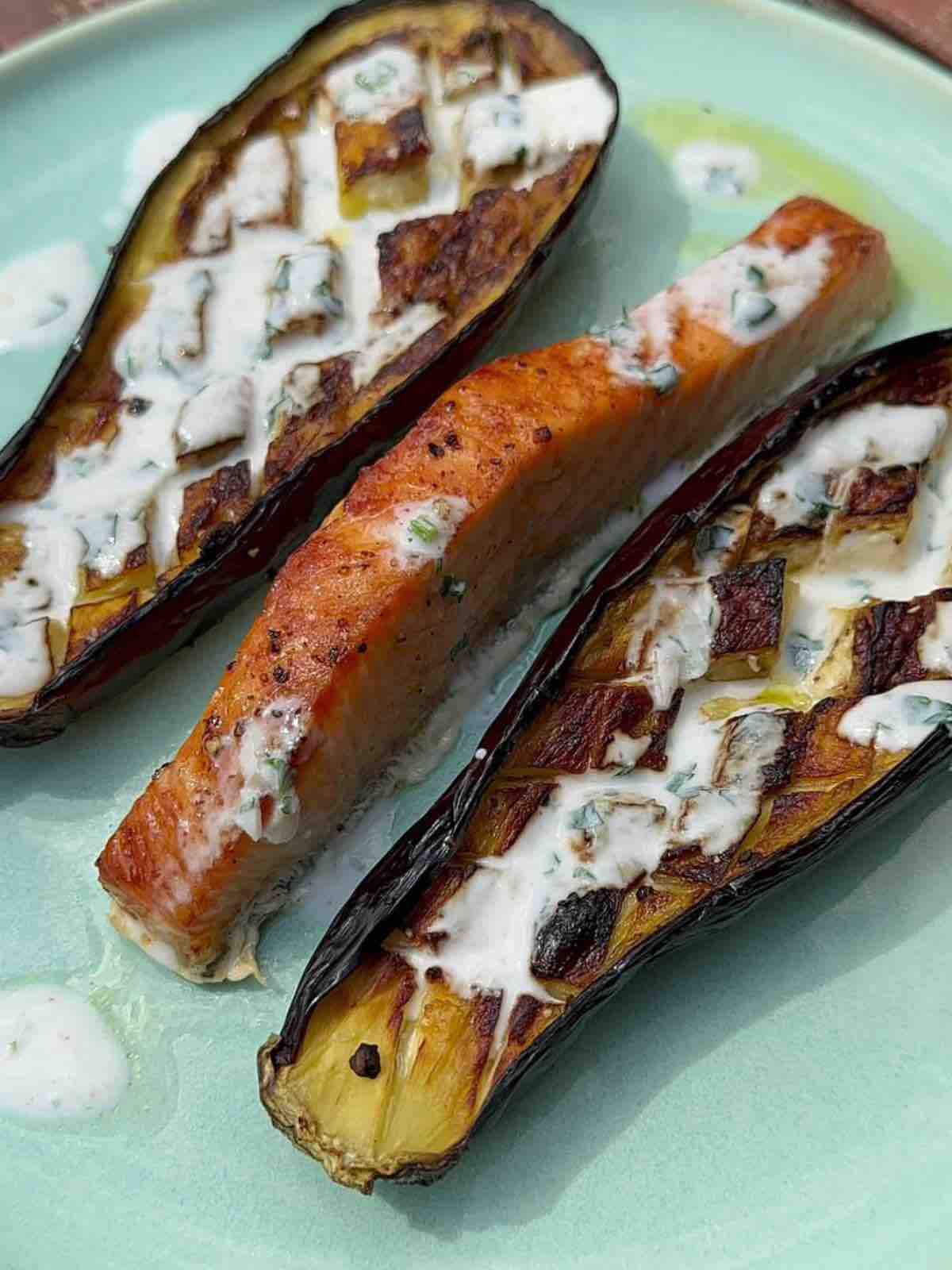Baked Aubergine with Yogurt Dressing
Baked Aubergine with Yogurt Dressing is a healthy and easy-to-make dish. Tender roasted aubergine slices topped with a creamy garlic and herb yoghurt dressing. Perfect for a light lunch or side dish!

I always find myself using the ingredients I have in my cupboard, especially before heading out for food shopping. I aim to utilize all the food I have to minimize food waste. It’s amazing how many interesting recipes come out of this process.
This veggie dish is ideal for a fast meal on busy days. Whether served as a main course or a snack, it’s bound to leave everyone wanting more. You should also try our Easy Tuna Rice Salad, Grilled Eggplant Salad, Turkish Borek with meat and cheese or Gnocchi made easy with Pesto and Zucchini for a quick delicious lunch or dinner.
OUR LATEST VIDEOS
Looking for more? Check out these Dinner Recipes!
I love quick, restaurant-quality dishes that taste amazing and are easy to make. In just 30 minutes, I can make a delicious meal for my family with ingredients I control. Sharing homemade meals creates special memories that last.
Watch Us Make The Recipe
Why you’ll love this recipe
This recipe for Baked Aubergine with Yogurt Dressing is a hit because it’s quick, easy, and uses basic ingredients. Aubergine and yoghurt are a delightful combination, and the dish is made even tastier with garlic and fresh herbs.
It’s a simple dish that’s perfect for busy nights. Since it’s homemade, you know exactly what goes into it, making it a healthier choice. Kids love it too, so it’s a win-win for everyone at the table.
Expert Tips
Use Greek Yogurt: Opt for Greek yoghurt for a thicker, creamier dressing. Add a splash of lemon juice for extra tang.
Roast the Garlic: Roast garlic cloves in foil with olive oil for a sweeter, mellower taste. Bake alongside the aubergine for best results.
Variations
Baked aubergine, also known as eggplant, is a versatile and delicious vegetable that can be prepared in various ways. Here are a few popular variations of baked aubergine:
Aubergine Parmigiana: This Italian classic is made by layering baked aubergine slices with tomato sauce, mozzarella cheese, and Parmesan cheese. It is then baked until the cheese is melted and bubbly. It’s a hearty and satisfying dish.
Stuffed Aubergine: Cut the aubergine in half lengthwise and scoop out the flesh, leaving a shell. Chop the scooped-out flesh and sauté it with onions, garlic, and your choice of vegetables and herbs. Fill the aubergine shells with the mixture, top with cheese if desired, and bake until tender.
Greek Moussaka: Moussaka is a popular Greek dish that combines layers of baked aubergine with ground meat (typically lamb or beef), tomatoes, onions, and spices. It is topped with a creamy béchamel sauce and baked until golden brown and bubbly.
Middle Eastern Baba Ganoush: This is a delicious and smoky roasted aubergine dip. Roast the aubergines until the skin is charred and the flesh is soft. Remove the skin, mash the flesh, and mix it with tahini, garlic, lemon juice, and olive oil. Season with salt and pepper, and serve with pita bread or vegetables.
Aubergine Roll-ups: Slice the aubergine lengthwise into thin strips. Brush the strips with olive oil and grill or bake until tender. Spread a filling of your choice, such as herbed ricotta, roasted vegetables, or a savoury sauce, on each strip and roll them up. Place the roll-ups in a baking dish, top with cheese or breadcrumbs, and bake until golden and heated through.
Eggplant Salad is a tasty dish made with roasted or grilled eggplant. Popular in Mediterranean and Middle Eastern cuisines, it’s also known as baba ghanoush, melitzanosalata, or mutabbal. To make it, roast or grill the eggplant until tender, then remove the skin and mash or chop the flesh. Mix with other ingredients for a delicious result.

Soaking eggplants in water before cooking???
Aubergines, also known as eggplants, are often soaked in water before cooking for a couple of reasons:
- Reducing bitterness: Soaking aubergines draws out bitter compounds, making them taste better. This works well for different varieties and freshness levels.
- Preventing oil absorption: Soaking helps reduce the amount of oil aubergines absorb when cooking. This prevents greasy results, especially when pan-frying or deep-frying.
It’s important to note that not all recipes require soaking aubergines. If you’re making a dish where the bitterness or excess oil absorption is not a concern or if the recipe specifically instructs otherwise, you can skip the soaking step.
My Favorite Products
Shop my Favorite Items to personalize your home
Serving options
When serving Baked Aubergine with Yogurt Dressing, you have several options to consider. Here are a few serving suggestions:
Main Course: Serve the baked aubergine as the main dish accompanied by a side salad or some crusty bread. You can present it on individual plates, garnished with the yogurt dressing, fresh herbs like parsley or mint, and a sprinkle of toasted nuts or seeds for added texture.
Side Dish: Serve the baked aubergine as a side dish alongside grilled or roasted meats, such as chicken, lamb, or beef. Cut the baked aubergine into smaller pieces or slices and arrange them on a platter. Drizzle the yogurt dressing over the top and sprinkle with chopped herbs and a squeeze of lemon juice for brightness.
Appetizer: Prepare smaller portions of the baked aubergine and yogurt dressing to serve as appetizers. Cut the aubergine into bite-sized pieces or slices and arrange them on a serving platter. Place a dollop of yogurt dressing on each piece and garnish with fresh herbs. Serve with toothpicks for easy eating.
Mezze Platter: Include the baked aubergine with yogurt dressing as part of a larger mezze platter. Arrange a variety of Mediterranean-inspired small dishes, such as hummus, falafel, tabbouleh, olives, and pita bread. Serve the aubergine alongside these items, allowing guests to create their combinations.
Looking for more? Check out +20 Best Mains Easy Recipes!
Did you give this Baked Aubergine with Yogurt Dressing recipe a try? Please share your experience by rating it ⭐️⭐️⭐️⭐️⭐️ and dropping a comment below. Your feedback is greatly appreciated and fuels my passion for creating recipes!
Follow me on Instagram – Pinterest or Facebook and tag your creations
